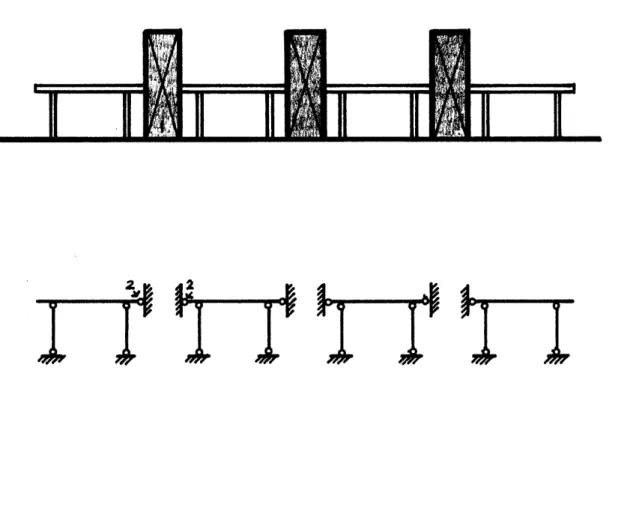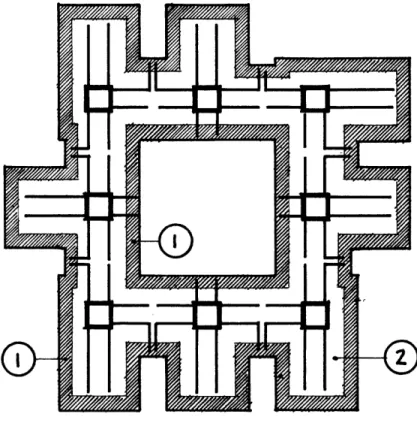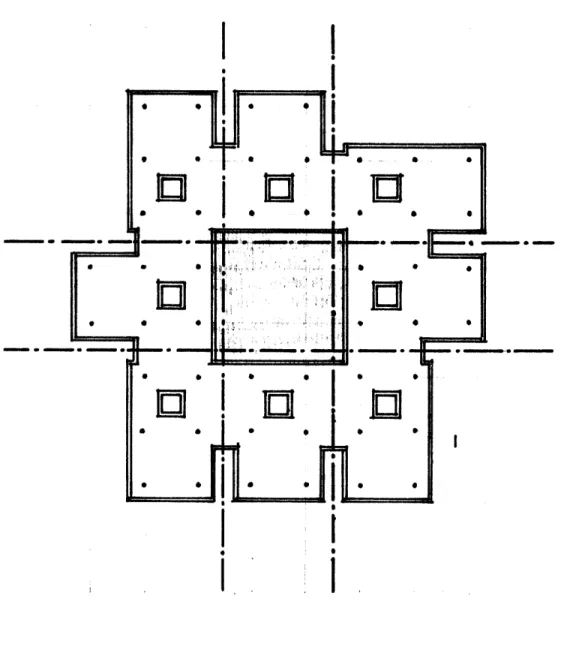.,>, *t.J
B U I L D I N G S A S S Y S T E M S
by Ary M. Pedju,
Ir. Ars., Institut Teknologi 3andung, Bandung, Indonesia, 1963
Submitted in partial fulfillment of the requirements for the degree of Master in Architecture at the Massachusetts Institute
of Technology, June 1965.
/A
Submitted by Certified by Accepted by Ary M. PedjuA
A Eduardo F. Catalano Thesis Advisor Lawrence B. AndersonCambridge, Massachusetts
June 15, 1965
Dean Pietro Belluschi
School of Architecture and Planning Massachusetts Institute of Technology
Cambridge, Massachusetts
Dear Dean Belluschi:
In partial fulfillment of the requirements for the degree of Master in Architecture, I hereby submit the thesis project entitled, "Buildings as Systems."
R
syectfully,
Ary M. Pedju
iii
A C K N O W L E D G E M E N T
The author wishes to thank the following whose assistance and advice contributed substantially
to this thesis project: Professors William A.
Litle and Peter Pahl of the M.I.T. Department
of Civil Engineering; Professors Waclaw Zalewski, visiting professor, and Eduardo Catalano, thesis advisor, and Mr. Leon Groisser, instructor, of the Department of Architecture.
C O N T E N T S Introduction . . Objective . . . Structural System . Mechanical System . Circulation System Growth System . . . Erection Procedure Bibliography . . . . . . . . . . . . . . .s . . . . . . . . . . . . . . . . .a . . . . 1
5
615
19 21 26 27 T A B L E O FI N T R O D U C T IO N
The architect, in the ancient as well as recent past, could be at once an artist and a technol-ogist, a designer and a builder. During the last half century, however, specialization of
know-ledge has so developed that various functions once performed by the same man are now done by different men. The rapid development in
technol-ogy, the increasing needs of the multiplied
number of humans (more housing, schools, factories, offices, theaters, laboratories, transportation depots, etc.), and the changes in the
civiliza-tion, the technological direction of our culture
--all these tremendous forces are challenging the architects of today and tomorrow. "The mass
media allow, compel, large numbers of people to
gather under the same roof for all the gregarious activities so typical of our era. Large stations,
large stadia, large churches, large theatres,
large arenas appear in increasing numbners. Urban
2
buildings. The large structure has become a symbol of our culture and a monument to its groups, be they governments, churches, or cor-porations."1
There is a tendency for the gap between archi-tecture and various branches of knowledge in refined modern technology to become larger and larger, since, according to tradition, the architect is trained primarily as an artist. In his article, "The Architect Within our
Indus-trial Society," Gropius says that the architect
is in a very real danger of losing his grip
in competition with the engineer, the scientist, and the builder, unless he adjusts his attitude and aims to meet the new situation.
Nevertheless, engineer Mario Salvadori responds: "The influence of structure on modern architec-ture is so prevalent that some architects wonder whether the engineer may not eventually take over the field of architectural design. The
growing importance of technical services and of
1. Mario Salvadori, Structure in Architecture,
structure suggests such a danger. And a grave
danger it would be, since the engineer, as a
technician, is not trained to solve the all-encompassing problems of architectural design. But these fears may, after all, be unjustified:
the engineer, while participating creatively in the design process, knows that in a group society like ours his role is limited to a col-laboration with the leader of the group. This
leader is and will always be the architect."2
Little thought is thus required to answer the
question of whether the architect should become more of an engineer or the engineer more of an
architect. Obviously, it is morally mainly up
to the architect to bridge the gap.
From earliest times, a sense of beauty has been
innate in man. It is questionable whether
archi-tecture which is deeply concerned with engineer-ing unavoidably leads to beauty. But it is undeniable that a correct'technological approach satisfies the eyes of even the most
able layman, and that a wrong approach is often offensively ugly.
Architectural beauty may be born healthy through the architect's capability of, in Nervi's words, "making formulas alive, more human and under-standing, and of lessening their impersonal
technical brittleness."3
O B J E C T I V E
The project objective was to design an integrated building system of space, structure, and services. This system is applied to a prototype building providing facilities for space research and
devel-opment. Emphasis is placed on developing a very
flexible system which will accommodate various changes in program. A great deal of emphasis is placed upon evolving a system which will permit expansion and growth of the building as needs require.
S T R U C T U R A L S Y S T E M
Structure is the only permanent system in the building. The systems which are not permanent, but are subject to change as required, are the mechanical and circulation systems and the system
of growth. The structure should accommodate all the dynamic systems and allow freedom for future changes in these systems within the
build-ing. It is obvious that a correct structural
system based on logic and simplicity of construc-tion will allow fulfillment of the above-menconstruc-tioned criteria.
Reinforced concrete was decided to be the basis
of construction, conceived as a prefabricated system of components with total standardization of its formwork.
One-way and two-way load dispersal systems have been considered as alternatives, and it is con-cluded that the latter is the one which is able to meet the architectural and structural needs.
For flexibility of interior space, beams and
girders should have equal depth. The logical way to have equal beams and girders is to use a two-way load dispersal structural system. The
ar-rangement of one-dimensional resisting elements is usually impractical and inefficient.
Prefabricated and prestressed techniques are used to take advantage of the new advances in indus-trialized construction. Also, since the building is of large dimensions and employs numerous
repetitive structural elements, precasting would be very practical.
The structural system chosen is a two-way
Vierendeel beam grid, with a span 80 feet long,
5
feet deep, and cantilevered at the ends. Thebeam arid is a 5-foot module, supported on hollow columns. Cores which are part of the structural
system are systematically located at the distance of every 160 feet.
The
5-foot
beam depth is chosen to satisfy thein the beams for air ducts and pipes, to serve a reasonable floor area. Perforations of about
3' x
3-5'
can be provided by this depth.The 80-foot span is assumed to be reasonable with
the
5-foot
beam depth, which gives adepth-to-span ratio of 1:16.
80
F7-The 5-foot beam grid is a convenient module for flexibility in room sizes, and is also indicated
in the use of 4-foot long lighting fixtures.
Bays on the perimeter have a 20-foot cantilever
all around the typical floor. A 1:4
cantilever-to-span ratio is used to obtain a good
accommodate the change of beam behavior encountered in structural growth (expansion). The increased negative moment can be controlled within this area.
00I A
EX PANSIONJ
Hollow columns,
5'
x5',
are provided to allocate6" drain pipes, 4" hot water, 2" cold water, and 2" ventilation pipes, and extra room for
addi-tional pipes and room to repair them.
Cores
40'
x40'
function as stabilizingstruc-tural elements, and within them are permanent,
fixed elements such as fire stairs, vertical shafts, toilets, elevators, electrical rooms, and janitors' closets.
10
cores provide simple structural behavior
through-out the building, adapted to the system of growth.
Details of the Structural Elements
Precise joinging of column to floor system is
facilitated by casting in place a 20' x 20' column
head integrally with the column. In addition to crossing ribs, diagonal ribs are provided at the corners of the column head, in the direction of
the principal stress line. These ribs are formed
by permanent fillers, with the usual concrete
reinforcement, as indicated in the detail drawings. Negative prestressing cables are located at the upper part of the ribs, at right angles to them.
Special openings are provided in the floor system to give access for installation and repair to
the pipes located in the column.
The dimensions of beams are based upon the
approx-imate analysis of mushroom slabs. It is
esti-mated that statics require a total positive and negative moment of:
Mo = 1/8 WL (1-- 2/3 c)2 L
where W is the total uniform panel load, L is
the span, and c is the diameter of the column
capital.
I I
Ml = 1/3 MO
-I2 = 2/3 MO
A straight strand prestressing method is con-sidered to be more practical, due to the
perfora-tions in the beams. Two stages of post-tensioning
are proposed; the second stage takes place after the floor system has been completed. The straight strand prestress method is not structurally
economical compared with the draped strand method, but the flexibility and the practical way of
prestressing that it offers may outweigh the
disadvantage.
Two typical sub-units are the 40-foot and the 10-foot long beams.
to 40
PLAN
Groups of units are post-tensioned at
5-foot
centers in the direction of right angles, re-sulting in a slab which is continuous over spans of 80 feet and cantilevered 20 feet long.
Floor panels are of
5'
x5t
precast concrete||
-- -- u~n -- -- -- -- --
--..
U~l~
2 2
Diagram showing theoretical stability.
1 - Core, functioning as stabilizer in horizontal
direction
2 - Hinge
1 - Poured-in-place column and column head
2 - Precast Unit A, 10' x 10f
3 - Precast Unit B, 10' x 40'
M E C H A N I C A L
Air Conditioning
The basic unit which is served mechanically is
the 120' x 200' basic unit of the building. Each
unit has a core with mechanical shafts, and is served independently.
The building is divided into two different zones,
that is, interior, and critical (exterior). Two separate systems of air conditioning are
pro-vided for these zones. The exterior zone extends
from the outside wall of the building to a point
15 feet inside, along the periphery. It is
assumed that rooms placed next to an outside wall would not be less than 15 feet deep.
An induction unit system is used for the critical
area. It is serviced from the mechanical floor
through the core by a high velocity air duct. The interior zone is controlled by an all-air two duct system, for supply and return. The main supply and return air branches are located in the areas
provided in the structural system where shear
forces are minimum.
Mechanical rooms are located in the basement and on the roof. Main air risers and returns are
located in the cores, and supply each floor from the mechanical rooms.
Air is supplied and returned on a 10-foot module. Duct space is figured at the rate of one square foot per 1,000 square feet of total floor area for the interior zone, and .25 square feet per
1,000 square feet for the induction unit system.
Only about
75%
of the air will be sent back toDiagram of air conditioning main lines.
1 - Exterior (critical) area
Each unit requires a total of
±
3500 square feetof cooling tower area, based on the calculation
of
5%
of gross area. The cooling towers will beevenly distributed on top of the building.
Refrigeration units and boilers are on the mechan-ical floor in the basement.
Piping
WVet mechanical services are located in the hollow columns. They originate and terminate in the mechanical floor. Fume hood exhausts are carried
C I R C U L A T 1 0 N
The circulation system is part of the buildingts
system. The location of structural elements such as columns and cores makes possible a clear and easy access to the building.
The circulation system lines run between cores in two directions, perpendicular to each other. Roads and ramps for cars, as well as entrances for pedestrians, are located on these lines.
Parking and service areas for cars and trucks are located on the ground floor and in the base-ment.
Lineal circulation within the building itself is mainly from core to core, around the open space.
Future circulation will follow the same system lines as the building grows.
141
W a a
I
0
1
Diagram showing circulation lines.
G R O W T H
Orderly future changes and growth of the building depend on a growth system integrated with the structural, mechanical, and circulation systems. While the provision of the growth system has been
the most decisive factor in designing the total system of this building, the growth system de-pends on a successful structural system: one
which, as the strong backbone, is both the perma-nent element and is capable of growth. The design of mechanical and circulation systems has also been based on this dual principle of permitting, and providing the order for, future growth.
The growth system is based on the 120t x 200' basic unit of the building, with its independent mechanical system. It follows the order of the
structural, column and core, lines, and the circulation lines.
To add one bay to the building, the cast-in-place
22
constructed, and then the infilling floor system
would be placed between the columns and existing
structure and joined by post-tensioning. If more
than one bay is to be added, all the additional columns would be constructed and floor system joined to them, but would not be joined to the previous building until the entire flooring sys-tem is completed, so that the removal of the
partitions and walls in the old building need not take place until the last moments of the
construc-tion period.
The spacing of columns and cores in future expan-sion would always follow their system lines, that is, 80 feet for columns and 160 feet for cores, to maintain the uniformity of structure and the
order of circulation.
The advantages of structural continuity are gained with this growth system. The structural system
is designed to withstand the changes in structural behavior that result from the addition of one or more bays.
23
The "direction", that is, the long axis of the
individual unit, may be perpendicular or parallel to that of other units, giving richness to the elevation and permitting growth adapted to an irregularly shaped site. This is made possible
by the off-center location of the cores. The system also makes provision in future expansion for the fully- or partially-enclosed exterior open spaces which give the building "life".
or--cone
.1 ~ E
t OF CORES
S
I
I
I
I
I
i
A possible growth scheme.
E R E C T I O N P R O C E D U R E
Footings, basements, retaining walls, etc.
Cast-in-place column and column head.
Temporary supports around the column to place the small unit, Unit A, around the column head.
Placement of Units B.
Post-tensioning, stage 1.
Placement of precast floor slabs.
Post-tensioning, stage 2.
Repeat procedure.
Finishing.
Topping is poured after the floor system is completed; with the slab units it works
struc-turally as a shear plate.
Mechanical system is installed after each floor is completed.
B I B L I 0 G R A P H Y
American Concrete Institute, A C I Building Code Requirements for Reinforced Concrete. Detroit,
Michigan, 1963.
Fred Angerer, Surface Structures in Building. Reinhold Publishing Corp., New York, 1961.
Phil M. Fergusson, Reinforced Concrete Funda-mentals, with Emphasis on Ultimate Strength.
John Wiley & Sons, New York, 1963.
Walter Gropius, "The Architect Within our
Indus-trial Society," from Scope of Total Architecture. Collier Books, New York, 1962.
Mario Salvadori, Structure In Architecture.
Prentice-Hall Inc., Englewood Cliffs, New Jersey, 1964.
Stressteel Corporation, Stressteel Post-Tensioning. Wilkes-Barre, Pennsylvania, 1961 and 1963.
~hiJl
-S
IUILIIBS Al SI~l
L -t
t tt - t - nn -- + M . . II IT 04;- T 01 CI~llNIN llI iM vQl IN i S S Y A- PRpTPaEEA C B R R sCdn
-F+il
,Li(Il!1,e
. .II I ~ v I I I I sv 3
[ThJ313lF l19
q p l I I
or a i d A v i s6i igPr si siI i ion i v II ilis N
19111 N3 11 10 I1lliSIl SIII S1vssI
AV01V10 81 INV3938 1A 1010 d y h II A S S N l1n I
I I ? 3 4 5 II
[I201 il APICAL NAY
B U I LDINGS A S S Y S T E M S
A PROTOTYPE RESEARCH LABORATORY
MASS A[HSIIIS INSI ll 11 1h 19h6y
If...
T TI
---- .- - - W - Tya .e - -I BIt .ig . .F I a I ItIIII Jll I HT .. ... m. i i~ .... ...II
I4x~ K~ 7- Pr >4 -~ \'A A ~-B
p. I 4 "* A ~ ~ $9 U; IU I L D I NG S A S 3 Y3 T EM SA PROTOTYPE RESEARCH LABORATORY
MASSACHhSFIS IlSI'IlIll l IIc 1910by
MAS I N l1 ANI[ IIIC I I lLSIS JUi A1965 ANY PI JU
I111 NI
.
l/iI
-"
II,
~


